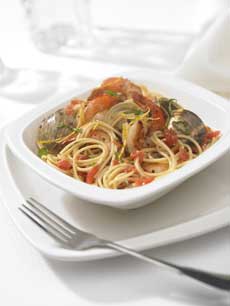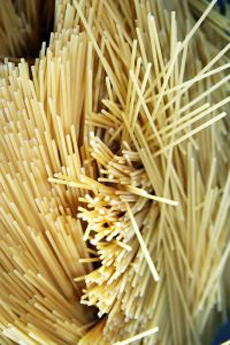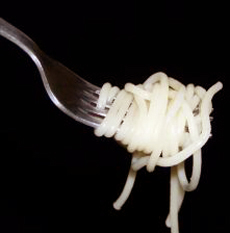

Finally, pasta could be made by machine—extruded through dies to eliminate the tedious hand-rolling and hand-cutting. Photo courtesy Barilla.
October 2007
Last Updated February 2012
|
 |
The History Of Italian Pasta
Page 3: Pasta Makers In Naples Invent Dies To Make Pasta
This is Page 3 of a five-page article; here, an introduction to pasta history. Click on the black links below to visit other pages.
Finally: Machines To Make Pasta
By the 1600s, in an industrial revolution in Naples, a process was invented to extrude the dough through a mechanical die, allowing for the large-scale, efficient production of pasta. This allowed the pasta to have a long shelf life, and brought Naples out of a severe economic depression.
Imports of meat and fresh produce had become expensive, but flour was available, and pasta had become more affordable after the invention of the mechanical press. Dry pasta quickly became the people’s food, to the point that Neapolitans were commonly called mangia-maccheroni (macaroni-eaters).
Southern Italy had hundreds of artisan pasta makers. The number of pasta shops in Naples grew from 60 in the year 1700 to 285 in 1785.
Although pasta became very popular, dry pasta was the food of the man in the street. Since its introduction, it was eaten using the hands (remember its origins as a soldier’s field provision).
Pasta was sold as street food by vendors called maccaronaros, who cooked it over a charcoal-stoked fire. It was eaten on the spot with bare hands—plain or sprinkled with grated sheep’s or goat’s cheese, but no sauce.
The wealthy, who did not eat with their hands, ate fresh pasta stuffed and seasoned with cheeses and meats, lasagna-type preparations that had been around since Roman times and the newer dumpling styles from China.
|
|

Much more pasta could be made by machine than by hand. Photo by Dave Van den Eynde | SXC.
|
The Fork Enables Spaghetti
Around 1700, one of the chamberlains to King Ferdinand II thought to use a fork with four short prongs to eat the long strands of cooked dried pasta.
After that, eating long “strings” of pasta became a common practice. It enabled pasta to be served at banquets all over Italy, and from there to all of Europe and the world.
|
|

The fork enables the enjoyment of long cuts of pasta. Photo by Karolina Michalak | SXC.
|
Tomatoes Are Added To Pasta
The next big advancement occurred a hundred years later, with the marriage of pasta and tomatoes. Although yellow cherry tomatoes had been brought back from the New World by Christopher Columbus at the turn of the 16th century and then by Hernando Cortez in 1529, they were used as a houseplant. (The Italian word for tomato is pomi d’oro, golden apple.) The fruit, a member of the nightshade family, was viewed as poisonous. Lean times drove peasants to try the fruit, with happy consequences. The first documented tomato sauce recipe is from 1839.
Continue To Page 4: Pasta In America
Go To The Article Index Above
Content copyright © 2005-

|






